Theater Reviews
All’s Well That Ends Well and Hamlet at The Stratford Festival, 2022
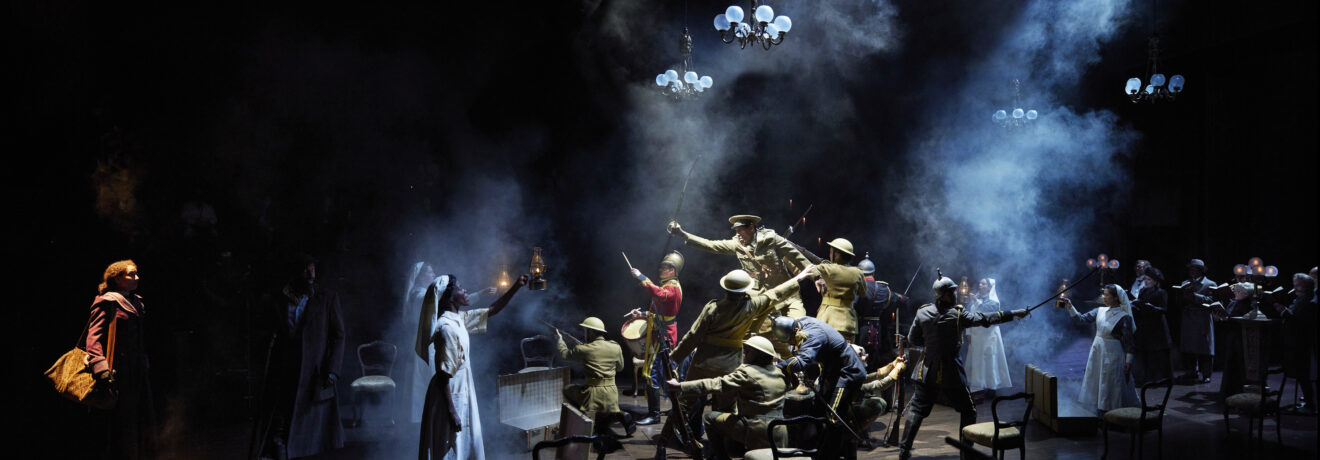
The Stratford Festival’s production of All’s Well That Ends Well was uniformly excellent. This performance deepened my appreciation of All’s Well’s potential as a script for an engaging and thought-provoking theatrical experience.
Much of Shakespeare’s career as a writer of comedies is devoted to a series of experiments in dramatizing what I would call “amazing grace.” Characters whom many audience members may find totally undeserving–Bertram is a fine example–are forgiven so suddenly that some critics and reviewers have dubbed this play (as well as Measure for Measure and other works) a “problem comedy.” The assertion that plot and characterization in All’s Well are problematic is also based in large part on the bed trick, which strikes many critics (understandably) as virtually impossible to pull off. Yet Shakespeare seems to relish improbability, especially when he is dramatizing acts of forgiveness and / or the operations of providence. In the Stratford production of All’s Well Jessica Hill’s extraordinary performance as Helen rendered the plot considerably more believable: it led me to believe that love that persists beyond all reason might actually be possible. Helen’s struggles with the morality of the bed trick, her repeated insistence that the trick is lawful–despite the deception–because she and Bertram are married, and her visibly passionate love for Bertram, despite his rejection of her, enabled me to relate to her character and accept the bed trick device.
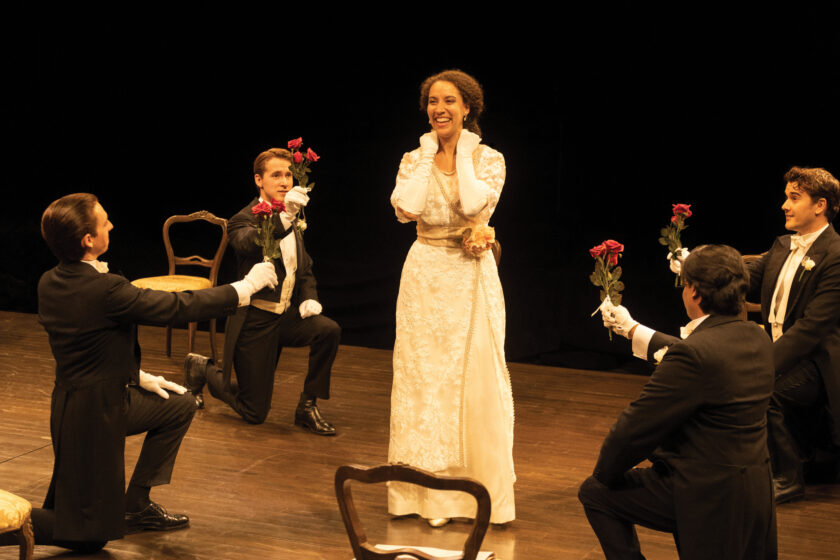
Hill portrayed Helen as typically serene and self-possessed, despite the emotional struggles that simmer just below the surface. Her love of Bertram impressed me as graciousness rather than mere infatuation, even though physical attraction was obviously a component. Moreover, Helen’s visible strength of character helped me to appreciate All’s Well‘s critique of aristocratic arrogance: a young woman, a commoner, evidently chosen by God to be a healer, is more worthy of respect than an arrogant nobleman such as Bertram.
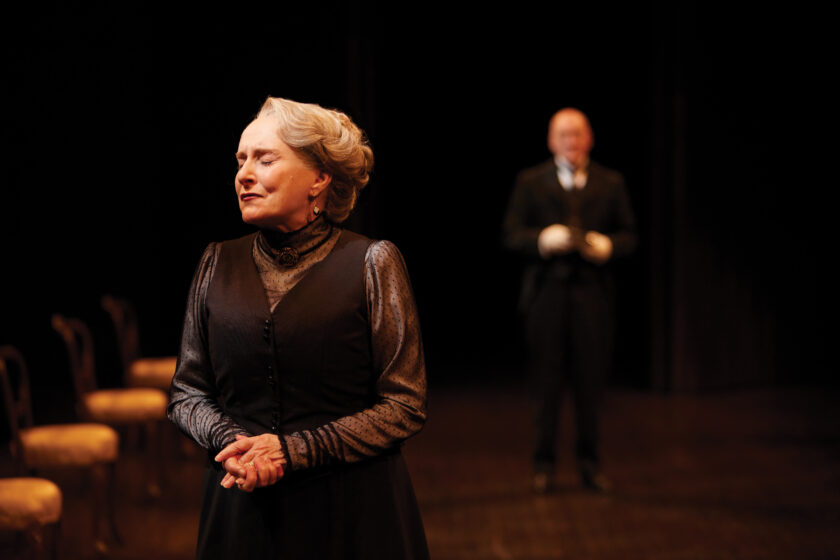
One factor that enhanced Helen’s character was the genuine love and respect for her expressed by the Countess of Roussillon, portrayed with depth and subtlety by Seana McKenna. McKenna’s Countess spoke to Helen with affection, sometimes with a gentle physical touch. When the Countess learned that Helen was in love with Bertram, she appeared to accept the prospect of a marriage because she recognized that Helen possesses a type of nobility that transcends what can be conferred by an inherited title. The King of France himself, played effectively by Ben Carlson, told Bertram
If she be
All that is virtuous–save what thou dislik’st,
“A poor physician’s daughter”–thou dislik’st
Of virtue for the name. But do not so.
From lowest place when virtuous things proceed
The place is dignified by th’ doer’s deed. (2.3.121-26)
Rylan Wilkie was superb as the braggart soldier Paroles. Wilkie, dressed in outlandish, largely red and yellow costume amidst a cast dressed in somewhat conservative late nineteenth or early twentieth-century attire, conveyed Paroles’s absurd braggadocio in a manner that made the character eminently worthy of ridicule and, eventually, punishment. Yet, after his downfall, he appeared genuinely downcast and repentant, and he was able to evoke some sympathy, thus preparing me for Lafeu’s compassion for him when he returned to France destitute: “though you are a fool and a knave, you shall eat” (5.2.51). Lafeu’s act of mercy toward Paroles obviously mirrors Helen’s forgiveness of Bertram.
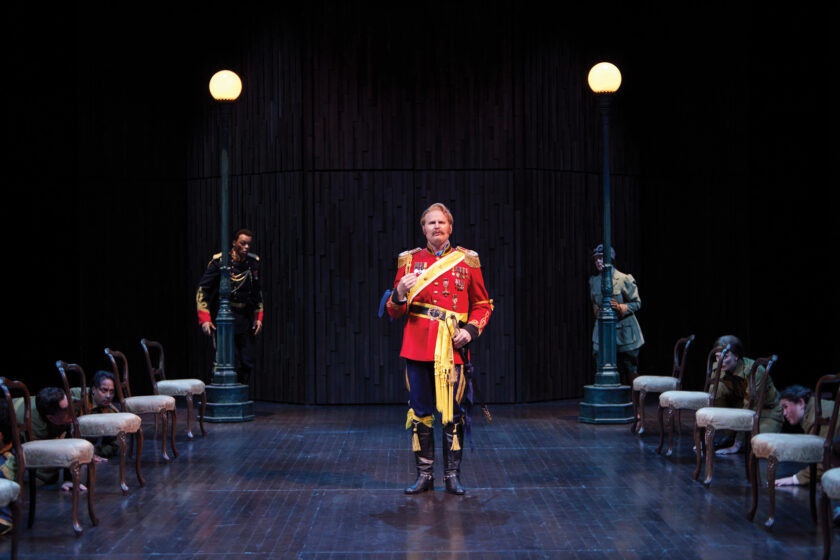
Although the new Tom Patterson Theatre was completed in 2020, the COVID pandemic prevented it from being opened immediately; 2022 was the opening season for this impressive theater, which is distinguished for the beauty of its architecture and the sophistication of its theater technology. Among its distinguishing features is an array of devices for noise suppression that “reduce the ambient sound to 10 decibels . . . , similar to that of a recording studio” (Green). The thrust stage extends through much of the auditorium, and the seating is raked very steeply, so that every member of the audience has a relatively close and unobstructed view of the stage. For All’s Well, the set consisted initially of chairs facing inward around the entire perimeter of the stage, with additional furniture (such as a bed for the ailing King) and props introduced as needed. This arrangement facilitated rapid transitions between scenes and helped to give the performance a sustained intensity. Readers who would like to see the architecture and the auditorium of the new Tom Patterson Theatre may wish to view The Stratford Festival’s video featuring a tour of the theater with commentary by the Festival’s Artistic Director Antoni Cimolino and architect Siamak Hariri (“Beyond Beautiful: Discover the New Tom Patterson Theatre”).
The performance script was edited judiciously, eliminating some of the play’s most obscure passages while retaining the essential components of plot, characterization, and the play’s most effective poetry and rhetoric, including the frequent emphasis on paradox. One significant change was moving (from Act 4 to the final scene) Diana’s statement that because she believes men to be deceitful, she will “live and die a maid” (4.2.74). The effect was to contrast Helen’s persistent desire to marry Bertram and to introduce an element of ambivalence into what might otherwise be played as a conventional romantic conclusion.
No performance can–or should–tame all of the contradictions and paradoxes of All’s Well That Ends Well. As the first Lord Dumaine commented when reflecting upon the fact that Bertram deserved praise for his valor and shame for his treatment of Helen, “The web of our life is of a mingled yarn, good and ill together. Our virtues would be proud, if our faults whipped them not; and our crimes would despair, if they were not cherished by our virtues” (4.3.69-71). The Stratford Festival’s production helped me to see the play’s apparent contradictions as reflections of the moral and spiritual complexities of actual human existence.
The Stratford Festival’s production of Hamlet was thoroughly and successfully rendered contemporary in its setting, costumes, and, occasionally, judicious updating of archaic language. The palace guards used modern communication technology, and several characters used cell phones. Hamlet, for example, read “words, words, words” (2.2.189) from a cell phone rather than a book. Although the final scene was still a fencing match (with modern fencing attire and equipment), Hamlet killed Polonius with a pistol.
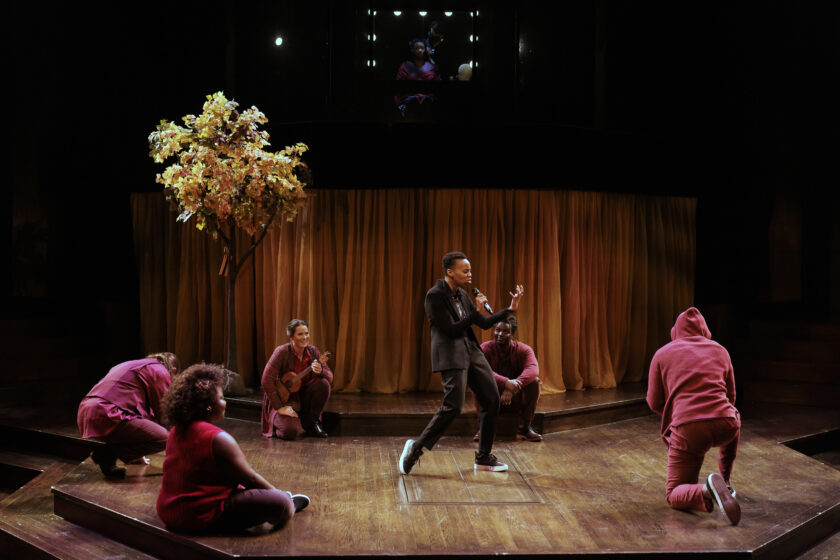
When the audience entered the theater, we saw the elder Hamlet’s body, in a dress white military uniform, in a glass enclosure on the stage. In front of the body was a security guard who watched the audience as we took our seats. Members of the audience who were inclined to focus on questions of literal realism (as I was not, in this instance) may have wondered how and why the body had been left on display for perhaps two months or longer. For me, however, the device of displaying the body at the outset of the play emphasized the dominant presence of Hamlet’s father looming over the production.
Occasionally, silent dramatizations that illustrated speeches being uttered in the main action appeared on the upper stage, including a romantic scene between Claudius and Gertrude. I found this to be an effective method of accentuating matters that were being discussed in the dialogue.
Among the most striking aspects of this production is the casting of Amaka Umeh, a gifted actress from Lagos, Nigeria, who is in her 20s, as Hamlet. In an interview in The Kit, Umeh comments on her connection to Shakespeare.
“Western theatrical tradition has divorced music from plays, where in African tradition there’s always music in plays. It’s our heartbeat, our universal language,” she says. “For me, Shakespeare has a beautiful union of those in the meter, the rhyme. To go back to that idea of reclaiming those voices that I can from across the ocean—from in the ocean—I so cherish the ability to sing a play, dance a play, without anybody realizing.” (“Meet Amaka Umeh . . . “)

In a moving remark that suggests how she relates to Hamlet, Umeh says that “Black people have this intense connection to grief and to loss, especially when it comes to our fathers, our sons, and our brothers. Those images are really palpable to me” (“Meet Amaka Umeh . . . “). Umeh’s emotional connection to Hamlet seems to have contributed to her ability to portray Hamlet’s grief, his struggle to determine the truth of the ghost’s accusation, his anger, and his near madness. Indeed, I often felt that Umeh’s Hamlet, often extreme in his anger, teetered at times just on the brink of madness.
Among the many fine performances in this production was Hilary Adams as Ophelia. Ophelia’s mad scene is immensely challenging, and Adams made the transition from a lively, vivacious Ophelia to a madwoman quite convincingly. Maev Beaty persuaded me that Gertrude was passionately in love with Claudius until Hamlet led her to what impressed me as sincere introspection and, perhaps, repentance. Michael Spencer-Davis was an earnest yet amusing Polonius, and Graham Abbey was an effective Machiavellian Claudius, though he appeared genuinely afraid of an incensed Hamlet. One scene that puzzled me, however, was Claudius’s unsuccessful attempt at repentance, much of which was delivered not as a soliloquy but as a speech to a visibly astonished and perhaps terrified Polonius. I cannot think of a convincing reason why Claudius would thus reveal his crime.
In his Director’s Notes for the production, Peter Pasyk addresses the issue of how to edit the early texts for a production of appropriate length. Using some material from the First Quarto, the Second Quarto, and the Folio, Pasyk constructed an acting script that ran just under three hours in performance. The most significant decision was to cut all material relating to Fortinbras. There are ample precedents for this strategy, ranging from the Restoration through some prominent recent productions (Thompson and Taylor 27, 41, 115-16). Nonetheless, cutting Fortinbras deprives the playgoer of an important mirroring device: Fortinbras, Laertes, and Hamlet all seek to avenge a father, and both Fortinbras and Laertes pursue revenge in an immediately aggressive manner that contrasts with Hamlet’s soul-searching. Moreover, some of the passages that were deleted include an interesting critique of excessive militarism. One such passage is Hamlet’s assessment of Fortinbras’s invasion of Poland to wage war over “a little patch of ground / That hath in it no profit but the name” (4.4.17-18):
HAMLET. Two thousand souls and twenty thousand ducats
Will not debate the question of this straw.
This is th’impostume of much wealth and peace
That inward breaks and shows no cause without
Why the man dies. (4.4.24-28)
Also cut were Hamlet’s remarks in the graveyard scene on mortality as the great leveler that has reduced even Alexander the Great and Julius Caesar to dust.
Assessing the advantages and disadvantages of cuts such as these is not a simple matter. On the one hand, as I have suggested, there are interesting elements of the early texts that I missed. On the other, I respect the need to keep the performance at a reasonable length; even Kenneth Branagh’s film, which ran four hours and two minutes, was somewhat controversial because of its length. The script developed by Peter Pasyk for this production was coherent, and it could be performed within the length of time that I believe most members of a broad audience will find engaging.
My fifteen-year-old grandson, who had never read or seen Hamlet previously, also attended this performance. He was deeply engaged with it, and he told me that the contemporary setting made the play, in his terms, “more welcoming.” His response reinforced my impression that this production succeeded in mediating between a seventeenth-century script and a twenty-first century audience that included a number of teenagers and young adults as well as seasoned playgoers.
Both of the productions that I attended at the Stratford Festival managed, though in somewhat different ways, to make the plays accessible to a broad audience while retaining the most important components of the early texts.
Works Cited
“Beyond Beautiful: Discover the New Tom Patterson Theatre.” YouTube, uploaded by The Stratford Festival, 11 June 2021, https://www.youtube.com/watch?v=F5r-_LHYNB8. Accessed 6 May 2023.
Green, Jesse. “The Times’s Theater Critic Reviews Stratford’s New Theater.” The New York Times, 23 July 2022, https://www.nytimes.com/2022/07/23/world/canada/stratford-festival-theater.html. Accessed 6 May 2023.
“Meet Amaka Umeh, the New Star of Canadian Theatre.” The Kit, 6 June 2022, https://thekit.ca/culture/culture-celebrity/amaka-umeh-hamlet-stratford-festival/. Accessed 3 September 2022.
Shakespeare, William. All’s Well That Ends Well. Edited by Suzanne Gossett and Helen Wilcox, Bloomsbury Publishing Plc, 2019. The Arden Shakespeare Third Series.
—. Hamlet. Edited by Ann Thompson and Neil Taylor. Rev. ed., Bloomsbury Publishing Plc, 2016. The Arden Shakespeare Third Series.
Thompson, Ann, and Neil Taylor. Introduction to Hamlet, by William Shakespeare, pp. 1-168.
